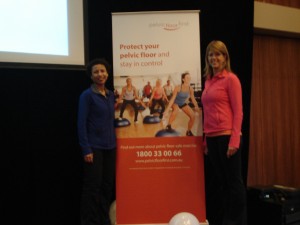
Have you ever been to a course, workshop, conference etc and just leave thinking wow?
To be completely honest with you up until mid last year I didn’t know a whole lot about pelvic floor muscles. And I’m a trainer. I knew they were muscles but I didn’t know just exactly how important they are to the functioning of our body. That is until I attended Exercise and the Pelvic Floor – a forum for health and exercise professionals organised by the Pelvic Floor First initiative, sponsored by the Continence Foundation of Australia.
Here are some scary statistics for you:
- 1 in 5 women have a bladder control problem
- 1 in 3 women who have had a baby
- 4.8million Australians are incontinent and of that 80% are women
I don’t know about you but that amount blew me away. Then I started to think about the women I know, clients, family, friends, associates and I began to think, my goodness I actually knew some of these women had an issue whether small or big and it didn’t really occur to me till now.
I personally can’t imagine what it would be like to not be able to cough, sneeze, laugh, jump or perform other high impact exercises without leaking. I am active all day long, demonstrating squats, running up and down stairs I could only imagine how uncomfortable and embarrassing it would be to not be able to control my bladder.
“The pelvic floor is the base of the group of muscles referred to as your ‘core’. These muscles are located in your pelvis, and stretch like a trampoline or hammock from the pubic bone (at the front) to the coccyx or tail-bone (at the back) and from side to side.
The pelvic floor muscles work with your deep abdominal (tummy) and deep back muscles and diaphragm to stabilise and support your spine. They also help control the pressure inside your abdomen to deal with the pushing down force when you lift or strain – such as during exercise.
Pelvic floor muscles support the bladder and bowel in men, and the bladder, bowel and uterus in women. They also help maintain bladder and bowel control and play an important role in sexual sensation and function.” – pelvicfloorfirst.com.au
Risk factors:
- Age
- High impact exercise
- Poor posture
- Low back pain
Smash those myths:
- You’re never too old and it’s never too late to increase your pelvic floor strength
- You still have to strengthen even if you have a c-section (load/pressure)
- You don’t have to just accept and live with it, you can make a difference
- Men have to worry too
So what to do? Start strengthening today.
I honestly thought it was an old person’s issue, I knew women who had a baby could also experience it but always thought it was something that just happened as you got older. I guess it is still a topic that is embarrassing and women are almost ashamed to talk about it. However after the conference I was so taken with the topic that I started talking to people straight away about it. I found out two things. One, more women than I knew actually had a problem with incontinence and two women around my age and who had not had a baby didn’t know much about it at all.
As a trainer I am hoping to raise the awareness of my clients of incontinence and how important your pelvic floor is.
I’m going to share my experience with you. Last year when I was in the height of suffering from my hip problem and sacro-iliac joint dysfunction a friend recommended me her physio. She had a hip problem and it turned out that her core played a pivotal role. I booked in and had a real time transabdominal ultrasound. I was in for a rude awakening. I thought I knew how to activate my core, in fact I often demonstrated it and talked about it all the time with clients. It turned out that my core was totally screwed up, I was overworking my muscles and in the wrong way to boot. The other scary part was that I had no ability to activate my pelvic floor and with that my transverse abdominus either. That was quite upsetting. It took a long time before I was able to isolate just the pelvic floor contraction and increase its strength before then working on the transverse. To be quite honest I found the whole thing very frustrating and tiresome. I would concentrate so hard and still my muscles would get confused. However with diligence I did improve and I have to say I’m glad it happened because it made me so aware of the core and its importance – pelvic floor included.
Up until the forum I didn’t really press the issue with all my clients. I would always make sure I included them with my pre and post natal and also those women preparing for falling pregnant. I hadn’t given much thought though on younger women and/or women who had not had a baby. They may not be at risk now but as they age their risk increases. Also, their sister or mother or friend might have a problem and if we can raise the awareness then we can lower those statistics.
Let’s give it a go –
I want you to imagine that hammock between your pubic bone and tail bone. Make sure your body is nice and relaxed. Take a breath in and on the exhale gently lift this hammock up and squeeze. The sensation is similar to that of stopping a wee midstream (don’t do that though!). Hold the contraction for approx 5 breaths or until you feel the muscle fatigue and/or other muscles step in to compensate.
You must be able to perform long holds and quick lifts and also be able to relax your pelvic floor completely (this will come in handy during childbirth).
Try this – a maximal lift with contraction. 5 long holds (5 breaths), 10 quick lifts and combine these, mix it up 3 times a day. Try to associate your exercises with an everyday task such as breakfast lunch and dinner or travelling to and from work. It doesn’t take long to do but certainly made a difference.
Here are a few more things I didn’t know until the conference
- There are two types of incontinence urinary and faecal (yep not being able to control wind or faeces
- When you have dysfunction of the pelvic floor you are at risk of prolapse (your organs – bladder/bowel/uterus – drop!! The pelvic floor supports these muscles)
- Dysfunction can also cause difficulty emptying bowels, pelvic pain, sexual problems or back pain
- Obesity and chronic constipation are a risk factor
- Pelvic floor works better in good posture
- Fatigue and anxiety affect the ability to engage the core
- Women ready for high impact exercise are those that can do 20 star jumps quickly whilst coughing on the last two reps
- Safe exercises for pelvic floor dysfunction include swimming, seated cycling, low resistance cardio machines, controlled hovers and planks
- You should be able to activate, hold and relax your pelvic floor during an exercise
Unfortunately I can’t include all the information in this one article. I could go on and on but I have made this article a lot longer than usual as it is!
Finally I just have to congratulate the wonderful women in the Pelvic Floor First initiative. The presenters were engaging and highly knowledgeable, at the end of the day we had question time with the panel and honestly it was one of the most interesting I’d ever heard. It was so interesting to hear from different ladies of different age groups, circumstances and careers with such great and relevant questions.
The day certainly gave me a lot to think about, which I am still informing my clients about.
Please visit www.pelvicfloorfirst.com.au or www.continence.org.au for more information.
(top photo is two of the 4 great presenters Marietta Mehanni and Lisa Westlake, Bottom photo includes Jacqueline and Sam from the Continence Foundation – i’m sorry about the blurry photos!!)
